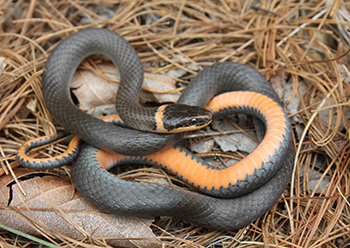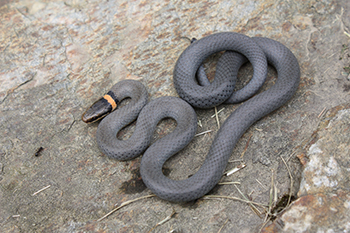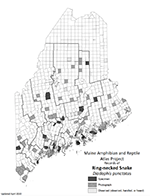Home → Fish & Wildlife → Wildlife → Species Information → Reptiles & Amphibians → Ring-necked Snake
Ring-necked Snake
Diadophis punctatus
On this page:

Photo: Trevor Persons
Distinguishing Characteristics

Photo: Trevor Persons
- Small, approximately 10 to 14 inches in length
- Bluish-gray above with distinctive band of yellow or orange across neck
- Underside yellow or sometimes peachy-orange
- Smooth scales
- May be confused with red-bellied snake
Status and Distribution in Maine
- Common and secure
- Statewide, but may be absent from northernmost Maine
Habitat
- Moist and dry woodlands and clearings
- Found beneath rocks, boards, debris piles, and decaying logs
Diet
- Eats invertebrates including ants, slugs, and earthworms, as well as salamanders, frogs, and small snakes
Seasonal Changes
- Hibernates in animal burrows, stone walls, rotting stumps, sawdust piles, and rock outcrops
Natural History Notes
- Secretive and nocturnal, likely more abundant than seems
- Lays eggs in communal nests with other ring-necked snakes in late June or July
- So-called “rear-fanged,” mildly venomous (but harmless to humans)
Share Your Sighting
There is much still to learn about the distribution and ecology of Maine’s herpetofauna, and we encourage members of the public to share their photo-documented observations as part of the Maine Amphibian & Reptile Atlas Project (MARAP).
To see if a township still needs documentation of a species, consult this distribution map (PDF). If a township lacks a photo or specimen record, we want your observation!
There are two ways to share your observations:
Submit your reptile or amphibian observation online
No service? No problem. Click here to download the survey to your device while connected, then take offline to collect observations from anywhere. Tip: The survey works best on Google Chrome and Safari.
Or upload sightings to the iNaturalist citizen science project through their website at iNaturalist.org or mobile app.
- When submitting an observation through iNaturalist add a description of the location (and other noteworthy information) to the “notes” field. This serves as a check on the locations automatically generated by smartphone cameras, which may be imprecise if cell service or GPS coverage is weak.
Thank you for doing your part to help conserve Maine’s reptiles and amphibians.
